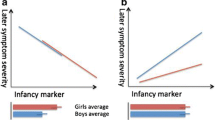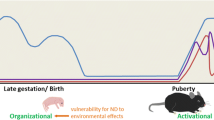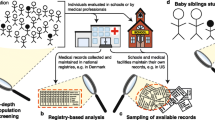Abstract
There are studies suggesting possible hereditary influence in autism. Data on 102 autistic children, 78 boys and 24 girls, showed that there was a significantly greater proportion of autistic girls than boys with IQs less than 50 and with evidence of brain damage. The autistic girls also had a greater proportion of relatives affected with autism or cognitive-language deficit than did the boys. The implication of sex differences in the possible mode of familial transmission of autism is discussed.
Similar content being viewed by others
References
Andrew, J., & Nathan, P. W. Lesions of the anterior frontal lobes and disturbances of micturition and defecation.Brain, 1964,87, 233–262.
Campbell, M., Hardesty, A. S., & Burdock, E. I. Demographic and perinatal profile of 105 autistic children: A preliminary report.Psychopharmacology Bulletin, 1978,14, 36–39.
Curnow, R. N., & Smith, C. Multifactorial models for familial disease in man.Journal of the Royal Statistical Society, 1975,138, 131–169.
Damasio, A. R., & Maurer, R. G. A neurological model for childhood autism.Archives of Neurology, 1978,35, 777–786.
DeMyer, M. K., Barton, S., DeMyer, W. E., Norton, J. A., Allen, J., & Steele, R. Prognosis in autism: A follow-up study.Journal of Autism and Childhood Schizophrenia, 1973,3, 199–246.
Falconer, D. S. The inheritance of liability to certain disease, estimated from the incidence among relatives.Annals of Human Genetics, 1965,29, 51–76.
Flor-Henry, P. Psychosis, neurosis and epilepsy: Developmental and gender-related effects and their aetiological contribution.British Journal of Psychiatry, 1974,124, 144–150.
Folstein, S., & Rutter, M. Infantile autism: A genetic study of 21 twin pairs.Journal of Child Psychology and Psychiatry, 1977,18, 297–321.
Gruenberg, E. M. Epidemiology of mental illness.International Journal of Psychiatry, 1966,2, 78.
Hollingshead, A., & Redlich, F.Social class and mental illnes. New York: Wiley, 1958.
Kanner, L. Autistic disturbances of affective contact.Nervous Child, 1943,2, 217–250.
Lotter, V. Epidemiology of autistic conditions in young children—I. Prevalence.Social Psychiatry, 1966,1, 124–137.
Martin, J. P.The basal ganglia and posture. London: Pitman Medical Publishing, 1967.
Ornitz, E. M., & Ritvo, E. R. The syndrome of autism: A critical review.American Journal of Psychiatry, 1976,133, 609–621.
Reich, T., Cloninger, C. R., & Guze, S. B. The multifactorial model of disease transmission—I. Description of the model and its use in psychiatry.British Journal of Psychiatry, 1975,127, 1–10.
Reich, T., James, J. W., & Morris, C. A. The use of multiple thresholds in determining the mode of transmission of semi-continuous traits.Annals of Human Genetics, 1972,36, 163–184.
Ritvo, E. R., Cantwell, D., Johnson, E., Clements, M., Benbrook, F., Slagle, S., Kelley, P., & Ritz, M. Social class factors in autism.Journal of Autism and Childhood Schizophrenia, 1971,1, 297–310.
Rutter, M. Psychotic disorders in early childhood. In A. Coppen & A. Walk (Eds.),Recent developments in schizophrenia. British Journal of Psychiatry, 1967, Spec. Publ. 1.
Rutter, M. The description and classification of infantile autism. InInfantile autism. D. W. Churchill, G. D. Alpern, & M. K. DeMyer (Eds.), Springfield, Illinois: Charles C Thomas, 1971.
Rutter, M. Infantile autism and other childhood psychoses. In M. Rutter, & L. Henson (Eds.),Child psychiatry: Modern approach. Oxford: Blackwell, 1977.
Rutter, M., & Lockyer, L. A five to fifteen-year follow-up study of infantile psychosis—I. Description of sample.British Journal of Psychiatry, 1967,113, 1169–1182.
Rutter, M., Tizard, J., & Whitmore, K. (Eds.).Education, health and behavior. London: Longmans, Green, 1970.
Rylander, G. Personality changes after operations on the frontal lobe: Clinical study of 32 cases.Acta Psychiatrica et Neurologica, 1939,Suppl. 20, 5–81.
Schlegel, R. J., & Bellanti, J. A. Increased susceptibility of males to infection.Lancet, 1969,2, 826.
Schopler, E. National Society for Autistic Children: Definition of the syndrome of autism.Journal of Autism and Childhood Schizophrenia, 1978,8, 162–169.
Schopler, E., Andrews, C. E. & Strupp, K. Do autistic children come from upper-middle-class parents?Journal of Autism and Developmental Disorders, 1979,9, 139–152.
Schopler, E., & Dalidorf, J. Autism: Definition, diagnosis, and management.Hospital Practice, 1980, June, 64–73.
Schwab, R., & England, A. C. Parkinson syndromes due to various specific causes. In P. J. Vinken & G. W. Bruyn (Eds.),Handbook of clinical neurology: Disorders of basal ganglia (Vol. 6). Amsterdam: North Holland, 1968.
Smith, C. Concordance in twins: Methods and interpretation.American Journal of Human Genetics, 1974,26, 454–466.
Spence, M. A. Genetic studies. In R. Ritvo (Ed.),Autism: Diagnosis, current research and management. New York: Halstead/Wiley, 1976. Pp. 169–174.
Spence, M. A., Simmons, J. Q., Brown, N. A., & Wikler, L. Sex ratios in families of autistic children.American Journal of Mental Deficiency, 1973,77, 405–407.
Taylor, D. C. Differential rates of cerebral maturation between sexes and between hemispheres: Evidence from epilepsy.Lancet, 1969,July 19, 140–142.
Washburn, T. C., Medearis, D. N., & Childs, B. Sex differences in susceptibility to infections.Pediatrics, 1965,35, 37.
Wing, L., & Gould, J. Severe impairments of social interaction and associated abnormalities in children: Epidemiology and classification.Journal of Autism and Developmental Disorders, 1979,9, 11–29.
Author information
Authors and Affiliations
Additional information
This research was supported in part by grants from the Iowa Mental Health Research Fund Grant and by a grant from the Bureau of Education for the Handicapped, No. 30770242.
Rights and permissions
About this article
Cite this article
Tsai, L., Stewart, M.A. & August, G. Implication of sex differences in the familial transmission of infantile autism. J Autism Dev Disord 11, 165–173 (1981). https://doi.org/10.1007/BF01531682
Issue Date:
DOI: https://doi.org/10.1007/BF01531682




